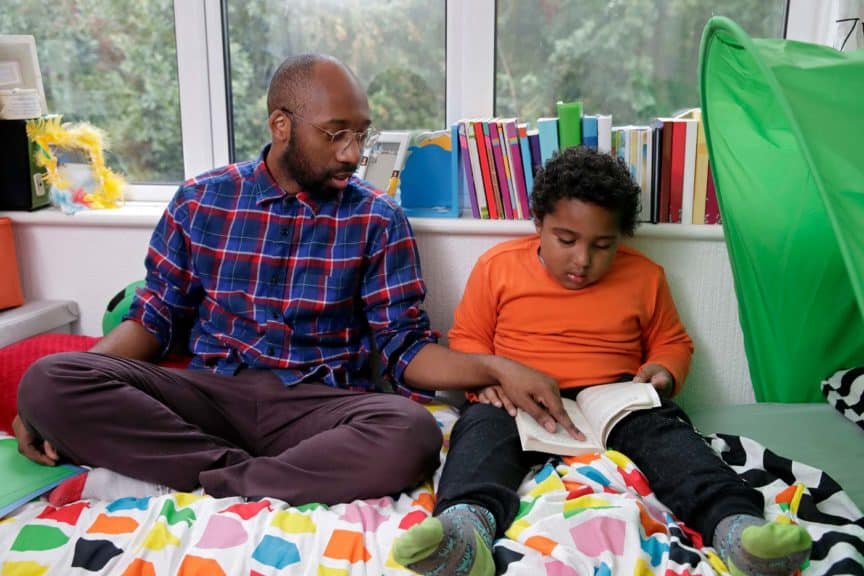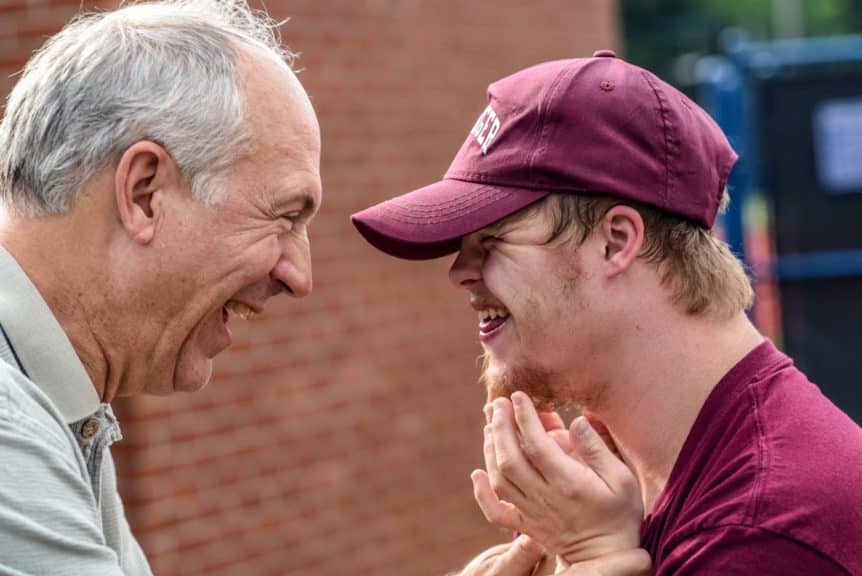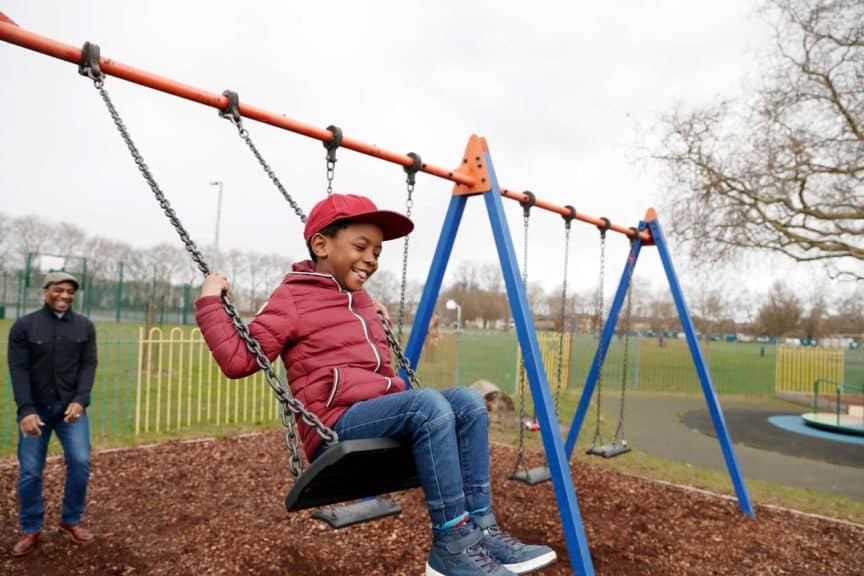When the topic of disability ministry comes up at church, a common first response is to ask anxious-sounding questions like:
- What will it look like?
- How much will it cost?
- Is it going to create risky situations?
Instead of letting fear-based questions end the conversation before it even starts, here are 10 questions to ask that will help your church assess its readiness for disability ministry and determine where to begin.
1. Do the special needs families and individuals in our church feel welcomed and supported?
This is the most important place to start. Your church already has people with disabilities, so ask them if they feel supported—and then really listen to their responses!
Asking this question in an open and receptive way will allow current members to say what you are doing well. Additionally, it will free them up to share where some extra effort could be really helpful.
You don’t want to spend the time, energy, and money on a breakout room only to discover the child can stay in her classroom if she has a visual schedule and a couple fidgets.

The special needs families and individuals at your church are your best resource to learn how you are already doing. Let them teach you!
2. Does our website tell the story of how our church welcomes and supports the differently abled?
This is really important. In this age of digital media, your church’s online presence is your first chance to make a healthy impression.
Information about disability support for families and individuals should be easy to find.
Visitors to your site should be able to type “disability” or “special needs” in the search box on the home page and get detailed information about your program.
It’s also helpful for them to find multiple ways to contact the disability point person at your church and access any forms you want newcomers to fill out.
If that’s not already happening, talk to your webmaster about creating a disability ministry page. Keep in mind that your goal is to clearly communicate that your church welcomes those with disabilities.
You might also start an Instagram, Facebook, or Snapchat account for your ministry. You can use them to announce upcoming events, share pictures (with permission), and engage with individuals who may want to check out your church.
3. What are the physical access barriers at our church campus?
This question can be especially complicated for congregations in older facilities. When we become familiar with a place, we adapt to it. We stop seeing the physical barriers because we’ve adjusted to them, so recognizing them can be difficult.
We stop seeing the physical barriers because we’ve adjusted to them, so recognizing them can be difficult.
Invite someone who is unfamiliar with your church—ideally someone with mobility issues—to tour the facility while you describe how your congregation uses the space.
He might observe that he loves to sing, but the choir is down a flight of stairs in the basement—a circumstance that excludes him from participating.

Solving Physical Access Problems Can Be Complicated.
- Some older buildings have been “grandfathered in” so they do not have to meet current codes, but making updates requires bringing the entire facility up to code.
- Building ramps, installing an elevator, and making bathrooms more accessible can be challenging—especially for church buildings with limited space.
- Cost is often a significant barrier to making changes.
Certainly many churches find that no amount of budgeting will free up the funds needed for a new ramp or chair lift.
However, I encourage you to look online for organizations that offer grants to help churches and other non-profits make their facilities disability friendly. One such grant opportunity is through Joni and Friends.
In the face of these potential challenges, keep in mind that you can often overcome physical barriers with creative thinking and open-mindedness.
Let’s return to our example of the choir in the basement: If building an elevator or ramp to make the basement fully accessible is not practical, perhaps the choir could relocate to a space on the ground floor.
As a result, this would create a new participation opportunity (and maybe a whole new Alto section!).
4. Is there a quiet place where people with sensory difficulties can participate in worship?
A quiet space in your church could have multiple uses. For example, it could serve as a nursing mother’s room, a prayer room, a sensory room, and/or a quiet room.
Imagine having a family with a disabled child visit your church while they are on vacation. A quiet space would enable their child, who struggles to sit through a service quietly, to move around or engage with a favorite activity while his parents could still hear the service.
Quiet rooms are also important for large churches and any church that uses stage lights, fog machines, and loud music.
Having a place where children can be themselves and parents don’t have to worry about disrupting or irritating others is a win-win.

Even if this space isn’t directly connected to the sanctuary, a good video monitor and a speaker—or even just a speaker—allows families to hear God’s Word and participate in worship.
5. Should we have a sign language interpreter?
People who are deaf or hearing impaired are looking for places to worship too. The deaf community in any given area is usually small but very tight knit.
If word gets out that you are able to offer sign language during the service, people will respond.
An interpreter’s presence is highly visible to the congregation and can encourage discussion among your members…
An interpreter’s presence is highly visible to the congregation, so it may encourage discussion among your members—and even between parents and children—about those around us who have disabilities and what we need to do to make the church a welcoming and accessible place to worship.
An added bonus is that a deaf interpreter can be helpful to all visual learners.
6. Could we create a breakout room?
We already talked about a quiet room for people who may get overwhelmed by elements of the worship service. A breakout room serves a similar purpose but is for your children’s or student ministry.
This is a place where students can go when they need a break from the larger group or are feeling overwhelmed by the kids around them.
Breakout rooms can be super simple—I’ve designed a breakout room using mostly items from dollar stores and garage sales. On the other hand, they can also be more elaborate with lights, swings, crash pads and ball pits.
If you want to create a spare-no-expense, state-of-the-art, super-high-tech breakout room, there are several catalogs and websites with ideas and options. (Warning: you could definitely spend some serious cash here!)

Did you know? David C Cook offers HeartShaper Children’s Curriculum, which includes special needs friendly activities that work well with all kids—each activity approved by special needs experts. Plus, HeartShaper offers free resources you can use in your ministry to kids with special needs. Check them out here!
7. Could we sometimes offer a sensory-friendly service?
Churches designating one of their services as “sensory-friendly” is an increasingly popular approach to making churches disability friendly.
Several things differentiate sensory-friendly services from a standard worship service. The music is basically “unplugged”—no electric guitars, no electric bass, no drum set, typically one singer with an acoustic guitar.
If your room is large enough to require using microphones, keep them at a low volume—just loud enough to help people hear the songs. In that same vein, make sure your room lighting is simple—no spotlights, smoke machines, or colored lights.
Help people feel comfortable moving around during music and when the pastor speaks. Also, ask congregants not to wear any perfume or strongly-scented lotion.

Items such as noise-cancelling headphones, weighted blankets, fidgets, and coloring books (for all ages) are available for worshipers to use as needed.
The lesson is usually designed to encourage interaction from the congregation—not only is this highly engaging, but it strategically normalizes compulsions to speak or make noise.
Designing a sensory-neutral space for people to worship in is a big step and can take a lot of preparation. But you don’t have to offer a sensory-friendly service on Sunday mornings, or even every week.
Providing a space for people with (and without) disabilities to worship in comfort is a priceless and transformative experience.
Providing a space for people with (and without) disabilities to worship in comfort is a priceless and transformative experience. I highly recommend considering this option for your congregation.
8. Does our church provide respite care?
You might be asking, “What in the world is respite“? Think of it this way: many parents who have children with disabilities are “on the clock” 24 hours a day, seven days a week, every week.
Childcare for disabled children can be much more challenging to find than childcare for normally abled children. Many parents of special needs children have given up vacations, date nights, and free time so they can care for their children.
And while they do it willingly, it is a heavy burden to carry. Marriages are more likely to end in divorce when parents have a child with disabilities.
The risk increases when the child has autism, is a teenager or adult, or has younger siblings (see this study).
These statistics challenge the church to find ways to provide the support these families need. One of the most effective ways is through respite programs.
Respite gives parents time to spend with each other, with typical siblings, or alone. And this all happens while you provide a lively and fun time with their disabled children, and in some cases with typical siblings.
There are many ways to offer respite care—try out alternatives to figure out what’s best for your church community.
How to Get Started with Respite Care
Because there are many ways to offer respite care, try out alternatives to figure out what’s best for your church community.
Some churches offer several hours on a Saturday to give parents some shopping time or a lunch date. And other churches provide care in the evenings and offer an optional dinner and speaker for the parents.
Choose to offer respite on the schedule that best fits your community—whether that’s weekly, monthly, quarterly, or annually.

In addition to thinking through how your church might offer respite on its own, explore how you might partner with other churches. Coordinating with other churches in the area and creating a rotation where families can have regular respite options available to them more often is a great way to serve them.
There are also several programs which can help you get started offering respite. Nathanial’s Hope is a one-stop shop. They will provide training, equip you with ideas for activities, and offer ongoing support.
You can also get resources through Joni and Friends and their Irresistible Church booklet series. In their book We’ve Got This (available online for free) you can get ideas, forms, outlines, and support.
But regardless of the way you choose, giving parents with disabilities a break from the everyday care of their children and giving them time to rest, regroup, or relax is a life-changing way to serve them and show them you are with them.
9. Are we asking “How?” or are we asking “Can?”
What does this really mean? When you ask “How” questions, you invite problem solving:
- “How can we find buddies?”
- “How can we do respite?”
- “How well can we equip this breakout room with a budget of $50?”
A “How” question is open-ended and implies you’re striving toward a goal. By contrast, “Can” questions invite “yes or no” answers instead of open exploration. “Can” questions are much more likely to lead to negativity and derail your momentum.
- “Can we find Buddies?” Nope.
- “Can we do respite?” Not yet.
- “Can we do a breakout room with $50?” Are you kidding me?
See how easy it is to slip into negative territory when the word “No” is an option?
One of the core principles of our church is “Anything’s possible.” And I find myself returning to that principle on a regular basis!
“Lord, I don’t know if I’ll be able to find enough buddies for this Sunday.”
“Lord, we have a medically fragile child whose parents want her to come to church. I’m not sure how we can do that.”
“Lord, I know we need to offer respite, but I’m so tired. Isn’t there someone else?”
Each time I run into a situation like this, I remember, “Anything’s possible.”
We serve the God of creation. He created the whole world and all that is in it. Don’t you think He has enough creativity to answer these questions? So ask for His creativity.
Trust that God will hear you and meet your needs. Ask Him “How?” and trust Him to answer.
Trust that God will hear and meet your needs.
10. Do we equip our “buddies” with tools for teaching (and not just childcare)?
Many churches use a buddy system for their Sunday morning special needs classes.
Each child is assigned a specific adult support person who helps them navigate children’s ministry—either in a self-contained setting or in an inclusion-friendly class or worship setting.
This is actually a fantastic practice because it allows a wide range of kids with disabilities to create relationships with a trusted adult who cares for them. And it provides families with the opportunity to worship together.
After you have used the buddy system for a while, you may find you are focusing on physical and relational needs while unintentionally neglecting spiritual needs.
I found myself doing this. I had buddy bags ready to go with fidgets and treats and gummies and all manner of items to keep our kids engaged and happy until mom or dad came.
After a while, I realized I had 6 kids in my program who were safe, happy, and cared for, but they weren’t being discipled. Ouch!
I felt convicted that the Lord wanted me to make disciples —not simply make sure kids were happy.
After prayer and repentance, I sat down to see how I could disciple our kids. Circle and group lesson time weren’t good matches for our special needs kids because those activities required a range of skills.
Leverage “Buddy Bags” for Discipleship
Then I remembered that each student already had a “buddy bag” and I realized I just needed to tweak what was inside.
I recognized that I needed to keep the treats, fidgets, and other items already in the bags. But I also needed to figure out a way to disciple.
I recognized that I needed to keep the treats, fidgets, and other items already in the bags, but I also needed to figure out a way to disciple.
I decided that each buddy bag would also get a Jesus pouch. The Jesus pouch includes a verse for the week, the Bible story the verse connects to, and a short craft.
Each buddy receives a digital copy of the Jesus pouch items in the bag for the next week, so they know what is coming. We encourage buddies to make use of the bag whenever it seems to be a good time.
We have had a lot of success with the buddy bags. One child loves to blow bubbles. While he blows bubbles, his buddy reads the Bible story to him.
Another child loves to swing. While the buddy pushes the child on the swing, she sings or recites the Bible verse.

After a few weeks, the kids started wanting to take out the Jesus pouch first and talk about the Bible story.
We had suddenly gone from babysitting the kids while mom and dad went to church to sharing the love of Jesus! Transformation was happening—and not just for the students.
We even had some buddies come up with questions about the lessons. They told us the lessons were helping them toward a deeper walk with Christ.
10 questions. 10 steps toward becoming a more disability friendly church.
Address these questions one at a time to avoid feeling overwhelmed. Talk to your families, prepare your church physically, analyze if you’re asking “How?” or “Can?”.
Take baby steps, and more baby steps, and then more baby steps. Pretty soon you’ll realize you have come a long way.
And you will have blessed families and kids and together come to a deeper understanding of the Heart of God.










